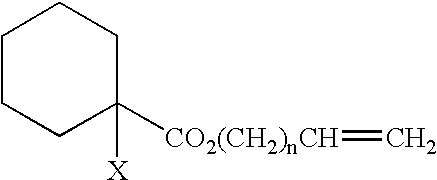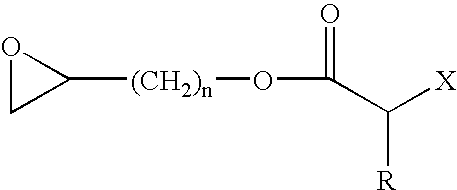Process for Producing Vinyl Polymer
a technology of vinyl polymer and polymerization catalyst, which is applied in the field of vinyl polymer production, can solve the problems of affecting the curability of polymers, affecting the color of vinyl polymers, and inability to remove polymerization catalysts completely, so as to achieve safe and efficient separation and effective separation of polymerization catalys
- Summary
- Abstract
- Description
- Claims
- Application Information
AI Technical Summary
Benefits of technology
Problems solved by technology
Method used
Image
Examples
example 1
Polymerization of n-butyl Acrylate
[0141]Using a total charge of 100 parts of n-butyl acrylate, a polymer was synthesized according to the following formulation. A reaction vessel equipped with a stirrer was charged with CuBr (0.42 part) and acetonitrile (8.79 parts), and the contents were stirred in a nitrogen atmosphere at 65° C. for 15 minutes. Thereto were added n-butyl acrylate (20.0 parts) and ethyl 2-bromobutyrate (1.90 parts), and the whole was thoroughly stirred for mixing up. Pentamethyldiethylenetriamine (0.034 part; hereinafter also referred to as “triamine” for short) was to initiate the polymerization. While heating at 70° C. with stirring, n-butyl acrylate (80.0 parts) was added dropwise continuously. During the dropping of the monomer, triamine (0.119 part) was added in divided portions. After the time of arrival of the monomer conversion at 95% or above, the polymer was kept in contact with an oxygen-nitrogen mixed gas with an oxygen concentration of 6% for 40 minute...
example 2
Copolymerization of n-butyl Acrylate, Ethyl Acrylate and 2-methoxyethyl Acrylate
[0146]Using a total charge of 100 parts of n-butyl acrylate, ethyl acrylate and 2-methoxyethyl acrylate, a polymer was synthesized according to the following formulation. A reaction vessel equipped with a stirrer was charged with CuBr (0.46 part) and acetonitrile (8.34 parts), and the contents were stirred in a nitrogen atmosphere at 65° C. for 15 minutes. Thereto were added n-butyl acrylate (5.53 parts), ethyl acrylate (7.95 parts), 2-methoxyethyl acrylate (6.52 parts), and diethyl 2,5-dibromoadipate (1.94 parts), and the whole was thoroughly stirred for mixing up. Pentamethyldiethylenetriamine (0.04 part; hereinafter also referred to as “triamine” for short) was to initiate the polymerization. While heating at 70° C. with stirring, n-butyl acrylate (22.13 parts), ethyl acrylate (31.81 parts), 2-methoxyethyl acrylate (26.06 parts) were added dropwise continuously. During the dropping of the monomer, tri...
example 3
Copolymerization of n-butyl Acrylate, Ethyl Acrylate and 2-methoxyethyl Acrylate)
[0150]Using a total charge of 100 parts of n-butyl acrylate, ethyl acrylate and 2-methoxyethyl acrylate, a polymer was synthesized according to the following formulation. A reaction vessel equipped with a stirrer was charged with CuBr (0.46 part) and acetonitrile (8.34 parts), and the contents were stirred in a nitrogen atmosphere at 65° C. for 15 minutes. Thereto were added n-butyl acrylate (5.53 parts), ethyl acrylate (7.95 parts), 2-methoxyethyl acrylate (6.52 parts), and diethyl 2,5-dibromoadipate (1.94 parts), and the whole was thoroughly stirred for mixing up. Pentamethyldiethylenetriamine (0.04 part; hereinafter also referred to as “triamine” for short) was to initiate the polymerization. While heating at 70° C. with stirring, n-butyl acrylate (22.13 parts), ethyl acrylate (31.81 parts), 2-methoxyethyl acrylate (26.06 parts) were added dropwise continuously. During the dropping of the monomer, tr...
PUM
| Property | Measurement | Unit |
|---|---|---|
| relative dielectric constant ∈r | aaaaa | aaaaa |
| relative dielectric constant | aaaaa | aaaaa |
| volume percent | aaaaa | aaaaa |
Abstract
Description
Claims
Application Information
 Login to View More
Login to View More - R&D
- Intellectual Property
- Life Sciences
- Materials
- Tech Scout
- Unparalleled Data Quality
- Higher Quality Content
- 60% Fewer Hallucinations
Browse by: Latest US Patents, China's latest patents, Technical Efficacy Thesaurus, Application Domain, Technology Topic, Popular Technical Reports.
© 2025 PatSnap. All rights reserved.Legal|Privacy policy|Modern Slavery Act Transparency Statement|Sitemap|About US| Contact US: help@patsnap.com



